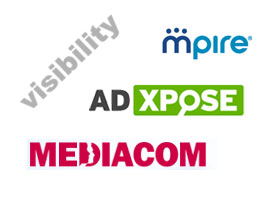 Mpire announced in a release today that over the course of four months, WPP Group agency, MediaCom, implemented Mpire’s AdXpose technology for a consumer electronics firm resulting in what it says was significant performance improvement by, among other things, “removing underperforming sites from the network buy.” Read the release.
Mpire announced in a release today that over the course of four months, WPP Group agency, MediaCom, implemented Mpire’s AdXpose technology for a consumer electronics firm resulting in what it says was significant performance improvement by, among other things, “removing underperforming sites from the network buy.” Read the release.
AdExchanger.com followed up with Mpire CEO Kirby Winfield…
AdExchanger.com: Are you surprised about the number of “underperforming sites”? What are some of the characteristics of these sites? Specific types of UGC, images, etc.?
KW: I am not at all surprised. I spent 10+ years in the search market, so I’ve seen the types of publishers and problems that can exist in a blind or unregulated environment. To me, the non-premium CPM display market, although it predates search, is way behind when it comes to quality control and fraud prevention. Impression fraud and unseen inventory, specifically, are rampant.
Advertisers, platforms and publishers have not traditionally viewed the impression-based ecosystem through the lens of transparency or site-level performance. Optimization generally occurs at the 10,000-foot level, with advertisers typically viewing performance at the network or exchange line, where items like passed tags, URL spoofing, URL padding, and specific publisher underperformance are simply not visible. The CTR and impression totals always magically turn out the way they should – it’s what informs those totals that advertisers need to be concerned with.
The good news is that there’s finally a focus on establishing some standards, and creating a marketplace where transparency, trust, accountability, quality are commonplace.
As far as characteristics of the sites, here are some red flags: hyphenated domains, unusual TLDs, movie sites, foreign UGC, Manga/anime sites, cricket/rugby/soccer sites, work from home sites. Of course, you have to be able to see the referrer URL to even catch these red flags.
AdExchanger.com: Is the brand marketer showing more interest in running awareness campaigns from your vantage point?
KW: Brand marketers continue to see consumers’ online media consumption grow to match television in terms of time spent, so they know they need to find ways to reach online users with their brands and messages. The challenge to date has been that they’ve had to trade reach for risk mitigation, buying narrow tranches of traffic and audience and ceding (to the belly-fat and teeth-whitening shops) the impressions representing 50%+ of time spent online. Also, they’ve had little ability to measure beyond the click – a performance-specific metric.
With services like AdXpose, brands will have more visibility into whether or not they got what they paid for, how their investment performed, and actionable information that will allow them to optimize their media and creative strategies. Some of our agency clients actually use AdXpose to support a cost per engagement model, which has been embraced by some major brand advertisers.
AdExchanger.com: How do risk management tools fit in the agency strategy going forward? And why?
KW: First, it bears noting that “audit-based” point solutions or site ratings services really only protect brands from a portion of risk (bad content), without using data to decrease fraud, improve performance or otherwise support growth in online spend.
As I mentioned before, advertisers have had to trade safety for reach. With a “risk management tool,” advertisers can increase their reach with much more visibility, confidence and reliability than they’ve had in the past; without feeling like they’re putting their brand at more risk.
As agencies move to in-house DSP’s and face questions about conflicts of interest and arbitrage/neutrality, solutions that provide transparency will play a big role in easing client concerns. We see agencies adopting and implementing transparent verification solutions at scale across 5%+ of all non-premium display buys within 2010.
By John Ebbert












